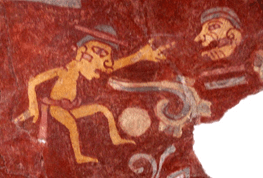by Luke Michael Ironside
In a consideration of language, communication and the relationship between the two, it is necessary to understand the function of the former in terms of human development, interaction, and expression. Language plays a highly significant role in daily human life. As a tool for social interaction, language provides us with the means to communicate with people and to understand them in turn. In such interactions, language is employed for specific purposes. We speak or write in order to express messages and ideas. This may be anything from asking the time of day to expressing one’s deepest emotions and thoughts.

A mural in Teotihuacan, Mexico (c. 2nd century) depicting a person emitting a speech scroll from his mouth, symbolizing speech
A Complex Relationship
Language and communication are not synonymous, although they certainly share an intrinsic relationship; communication includes language and yet, it also includes much else that could not rightly be considered language. Such a distinction may be exemplified in the fact that animals communicate and yet they cannot be said to possess language. However, the boundaries that separate one from the other cannot always be clearly differentiated. For example, in a recent 2013 study[1], baboons were found to be able to distinguish genuine words from nonsense words based on the phonological order of the word itself. Chimpanzees can be taught sign language and construct basic “sentences” through such gestures. Among non-primates, certain species of bird (such as parrots, hummingbirds, and songbirds) exhibit vocal learning patterns. An article in the National Geographic outlined a successful experiment in which a mother dolphin communicated with her young via telephone, with both dolphins seeming to understand who they were talking to and what was being spoken about.[2] Are these instances of language or merely communication?
Defining Terms
We must attempt to arrive at a practical definition if the distinction between the two terms is to be more clearly illustrated:
Language is a method of human communication and as such, an abstraction; a system of rules, conventions, symbols, and identifiers by which means ideas may be expressed. Language may take three forms: oral, written, or manual. Each relies on the process of semiosis to relate symbols to particular meanings.
Communication is the act of imparting or exchanging of information from one individual or group to another. This may occur through verbal or non-verbal means. When a complex system of semiosis, phonology, and syntax is devised or agreed upon among a group of people, whether consciously or not, communication takes place through the medium of language.
From these definitions, we can see that communication is much vaster than language in its scope, in that it occurs at various levels of complexity from simple to highly intricate, whereas language, by its very definition, is necessarily complex. Furthermore, communication can take place via any sensory channel, whether auditory, visual, or chemical. Language, on the other hand, was an entirely auditory phenomenon prior to the invention of writing.
This contrast may be further illustrated in the example of an infant’s cry, which, whilst clearly understood by its mother as an indication of need, want or discomfort, could certainly not be considered language. This form of basic communication is also commonplace in the animal kingdom, where simple information in the present that may be of interest or benefit to others (such as perceived danger, fear, hunger, etc.) is communicated through a variety of gestures, expressions, vocalisations, and physical contact.
A Human Phenomenon
Language, when strictly defined, seems therefore, to be unique to humans. Although certain animals exhibit relatively complex forms of communication, as illustrated in the aforementioned examples, studies suggest that it is only humans who possess the instinct to learn, speak, and understand language, and to use such in the expression of complex and abstract thoughts and ideas. Thus, as stated by the American linguist, Edward Sapir, “Language is a purely human and non-instinctive method of communicating ideas, emotions and desires by means of a system of voluntarily produced symbols.”
Indeed, it is this richness of human language that distinguishes it from simpler forms of communication, in that language possesses the ability to evolve and expand in response to the needs of our imagination. We can use language not only for the purposes of communicating information in the present but also for recollection of past events and the anticipation of future preparations. In its abstract usage, language enables us to conceive of grand ideas and new concepts; it can guide behaviour, shape our thoughts, and provide us with a broader vision of the world that we inhabit.
Language is a City…
The fact that language is constantly evolving, adapting, and synchronising further evinces its role in fulfilling human communication needs. In his essay on Letters and Social Aims, Ralph Waldo Emerson aptly observed that “Language is a city to the building of which every human being brought a stone.” Language is thus a collaborative process to which we each contribute through our participation and ongoing interaction. Indeed, the language of a decade ago differs from the language of the present (even if only if some slight colloquial respects), and a glance through any English book from a century ago will show just how significantly our language has evolved both lexically and grammatically since that time.
The question of the relationship between language and communication is thus one of the relations between a process and the tool whereby such process is performed. Language provides a means whereby the sender may effectively communicate a message to a receiver through a complex set of cultural symbols as expressed in speech and writing. Language is unique to humankind, in that whilst animals do communicate, sometimes in a relatively complex manner, it is only humans who possess the ability to learn, speak, understand, and construct language in an abstract or semiotic sense.
In any case, the study of language and communication is an ongoing one, with much left to be discovered. Certainly, the relation between the two is such that the study of one provides us with a clearer understanding of the other. The tendency of language to constantly change places us in the midst of a grand experiment, in which the evidences of the past coincide with the subtle developments of the present, and which position presents us with an empirical opportunity for continued experimentation and research. As teachers of English as a foreign language, we are constantly immersed in the intricacies of language at every level. We experience first-hand the enormity and the limitations of language in the process of our teaching and our acquaintance with cultures other than our own.
Which of your understandings of the connections between language and communication has been challenged as a result of your experience in teaching? In what ways would a richer compression of their relationship and differences improve our ability to teach effectively as language instructors in the 21st century?




